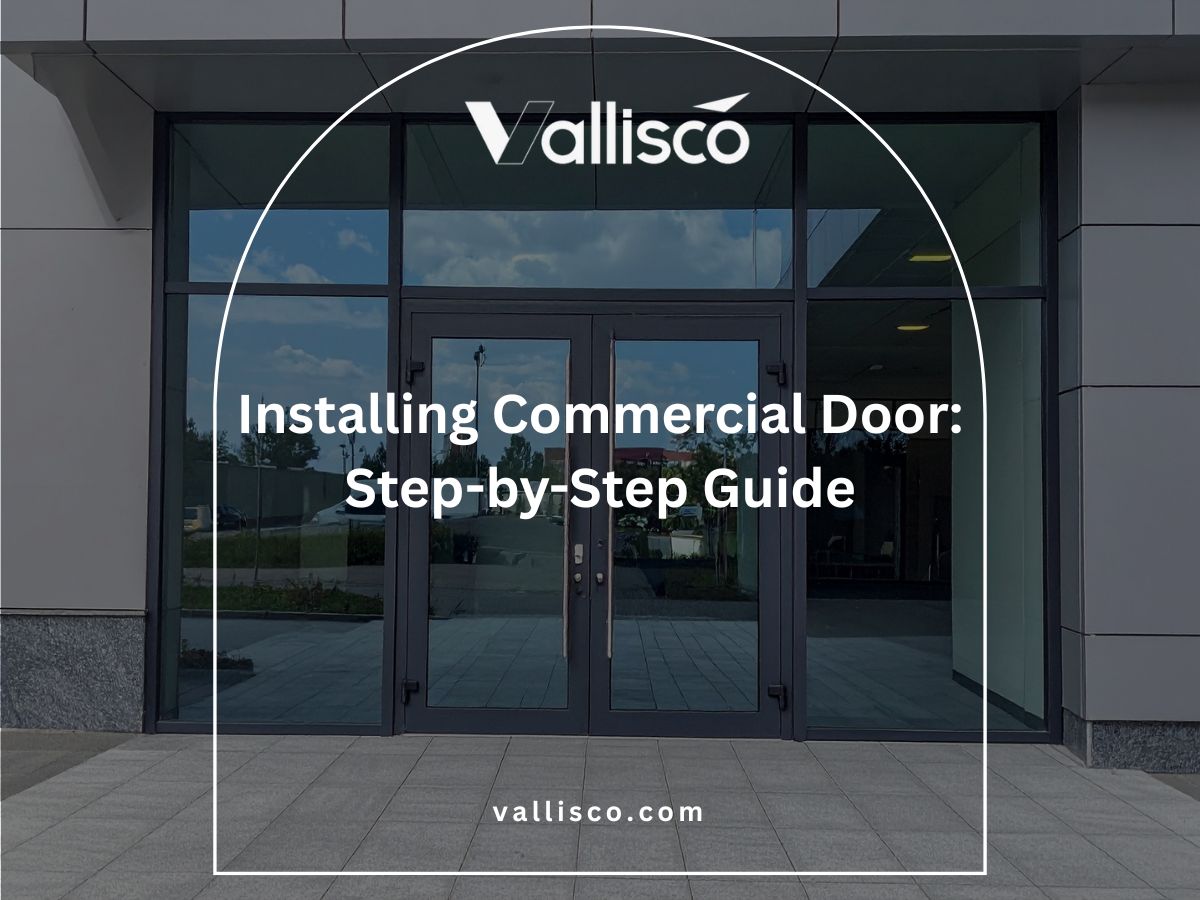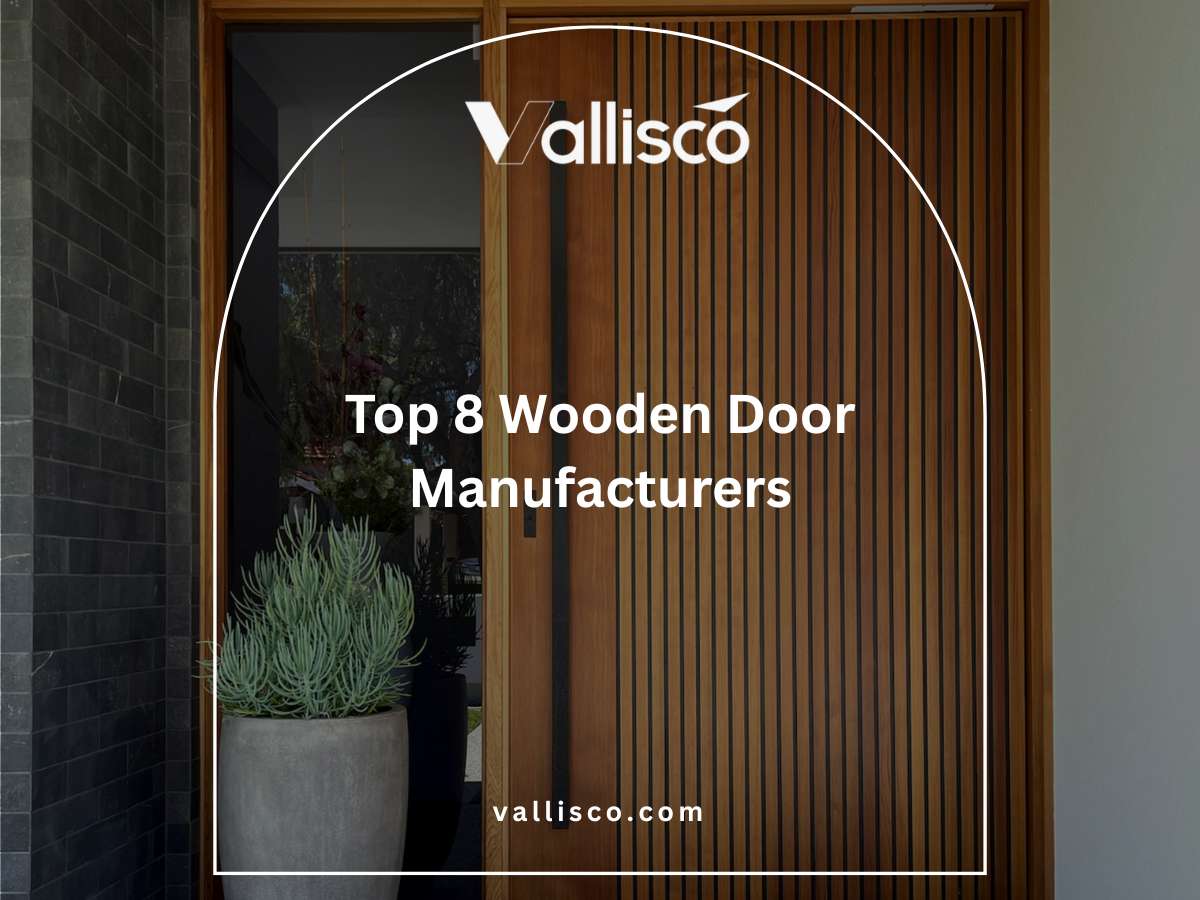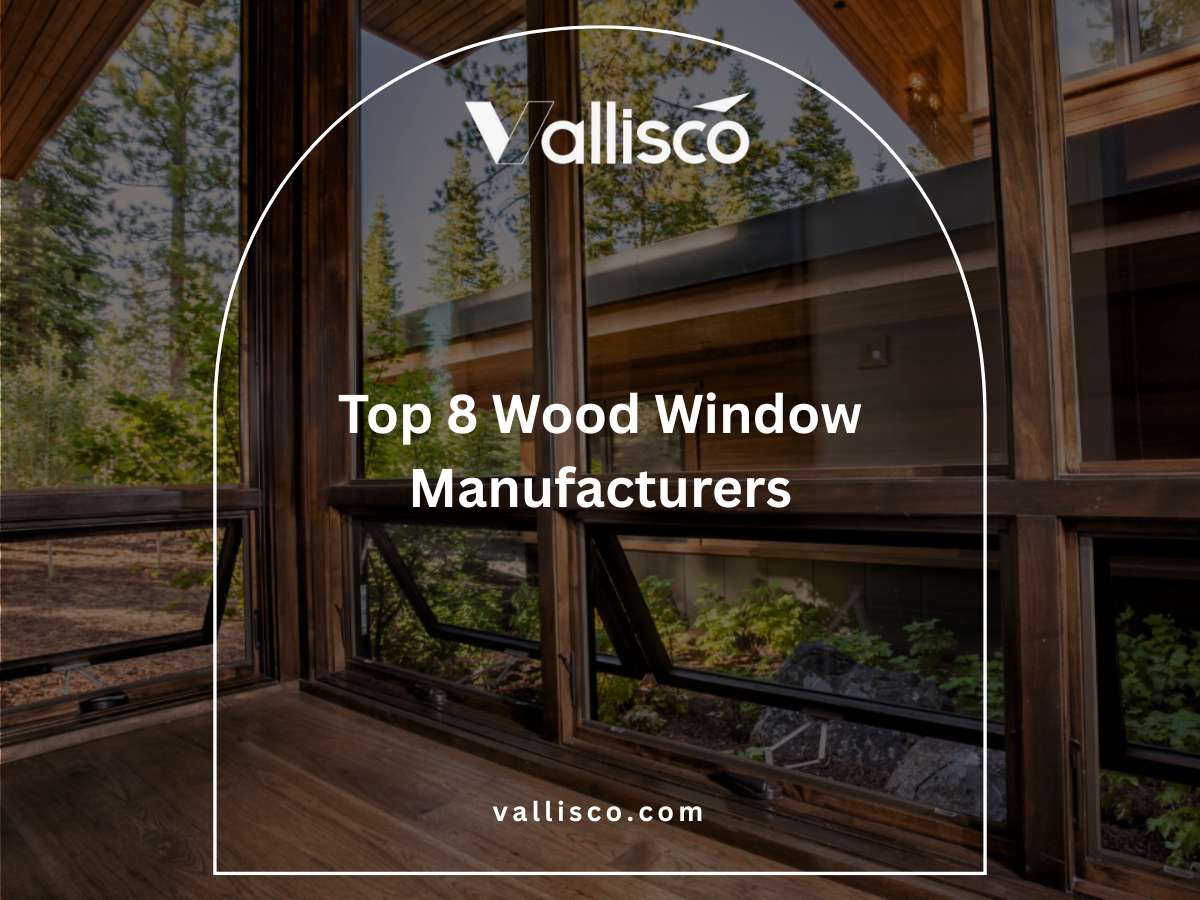A hotel client once asked me why their new bathrooms felt unfinished. The problem wasn’t the tiles or lighting, it was the doors. They didn’t match the modern style of the space.
That conversation made clear how easy it is to overlook doors, even though they influence the whole room.
I’ve spent years supplying doors for villas, houses, and hotels. I know the common mistakes and what actually works in real projects. That’s why you can trust the ideas I share.
Here, you’ll find 8 modern bathroom door design ideas. They cover style, function, and materials, giving you clear options for your next project.
Your guests will notice, and so will you.
So, let’s get started!
Quick Comparison Chart
Modern bathroom door design comes in many styles, each with its own benefits. A quick overview helps you see the main differences in look, function, and material. This table will guide you before diving into the details:
| Door Type | Main Features | Common Materials | Style Impact | Best For |
| Sliding Glass Doors | Moves along a track, saves space, allows light flow | Tempered glass, aluminum/steel track | Clean, open, contemporary | Small bathrooms, modern interiors |
| Pocket Doors | Slides into wall cavity, frees floor space | Wood, MDF, glass panels | Sleek, seamless, practical | Compact layouts, hotels |
| Frosted Glass Panel Doors | Blocks view but lets in light | Frosted/etched glass, aluminum frame | Soft, light, modern | Bathrooms needing privacy + brightness |
| Barn-Style Sliding Doors | Mounted on exposed track, rustic or industrial look | Solid wood, metal hardware | Bold, rustic, decorative | Villas, inns, boutique hotels |
| Flush Wood Panel with Hidden Frames | Flat panel, hidden frame, minimal gaps | Veneered wood, MDF | Smooth, modern, high-end | Luxury homes, modern hotels |
| Bi-Fold Bathroom Doors | Panels fold together, wide opening in small space | Wood, PVC, composite | Practical, compact, flexible | Greenhouses, compact bathrooms |
| Mirror Finish Doors | Mirror surface doubles as function + design | Glass with mirror coat, MDF frame | Brightens, enlarges space visually | Hotels, bedrooms with attached bath |
| Pivot Doors with Vertical Handle Bars | Rotates on central hinge, striking entry | Wood, metal, glass | Bold, modern, architectural | Villas, spacious homes |
Each option has a place depending on your project’s needs. Read more below to see how each design works in detail and which one could be right for you.
1. Sliding Glass Doors
Sliding glass doors are one of the most common requests I hear from project owners. I’ve seen them used in villas, hotels, and even compact inns, and they always bring a fresh, open look. If you’re considering them, here’s what you should keep in mind.
Space and Layout Benefits
- Maximizes Usable Floor Space: The sliding motion removes the need for door clearance. This makes it easier to design compact bathrooms without wasted space.
- Helps Small Spaces Feel Bigger: Clear or frosted glass gives the illusion of openness. Even a small guest bathroom can feel less confined with this type of door.
- Improves Flow Between Areas: Sliding doors create a smooth connection between the bathroom and bedroom. Guests move comfortably without bumping into swinging panels.
Installation and Maintenance Notes
Installation
- Track Must Be Perfectly Level: The panel won’t glide smoothly if the track is uneven. I’ve seen this cause delays during hotel projects, so accuracy here saves headaches later.
- Wall and Ceiling Strength Matters: The wall or ceiling must be strong enough to support the track system. Reinforcement may be needed in older buildings.
- Professional Fitting Recommended: Unlike a standard hinge door, sliding systems need precise setup. Most clients hire skilled installers to avoid alignment issues.
Maintenance
- Regular Cleaning of Glass Panels: Glass shows stains from water and fingerprints quickly. Most owners plan for easy access on both sides for housekeeping staff.
- Lubrication of Track System: Dust and moisture can cause stiffness over time. Applying silicone spray keeps the movement smooth.
- Moisture-Resistant Hardware: Stainless steel or aluminum is best for humid bathrooms. Other metals may corrode and add to replacement costs.
Cost Considerations
- Glass Panel Price Range: Standard clear tempered glass runs lower in cost, while frosted or tinted glass adds around 15–25% more. For a hotel project, this difference adds up across multiple rooms.
- Hardware Investment: Quality track systems and rollers cost more upfront. A durable stainless steel system may add 20–30% to initial costs but prevents expensive repairs later.
- Cleaning and Upkeep Costs: Glass reduces warping issues seen in wood, lowering replacement frequency. Most long-term costs are in cleaning, which staff can handle as part of routine housekeeping.
Design Fit for Your Project
Sliding glass doors fit projects that aim for a bright, clean, and modern impression. Villas and hotels often use them to make bathrooms feel larger and more welcoming.
Privacy is an important factor. Clear glass may not work everywhere, but frosted or tinted options give you both light and discretion. This flexibility makes Vallisco’s sliding glass doors a safe choice for many projects, from small guesthouses to luxury buildings.
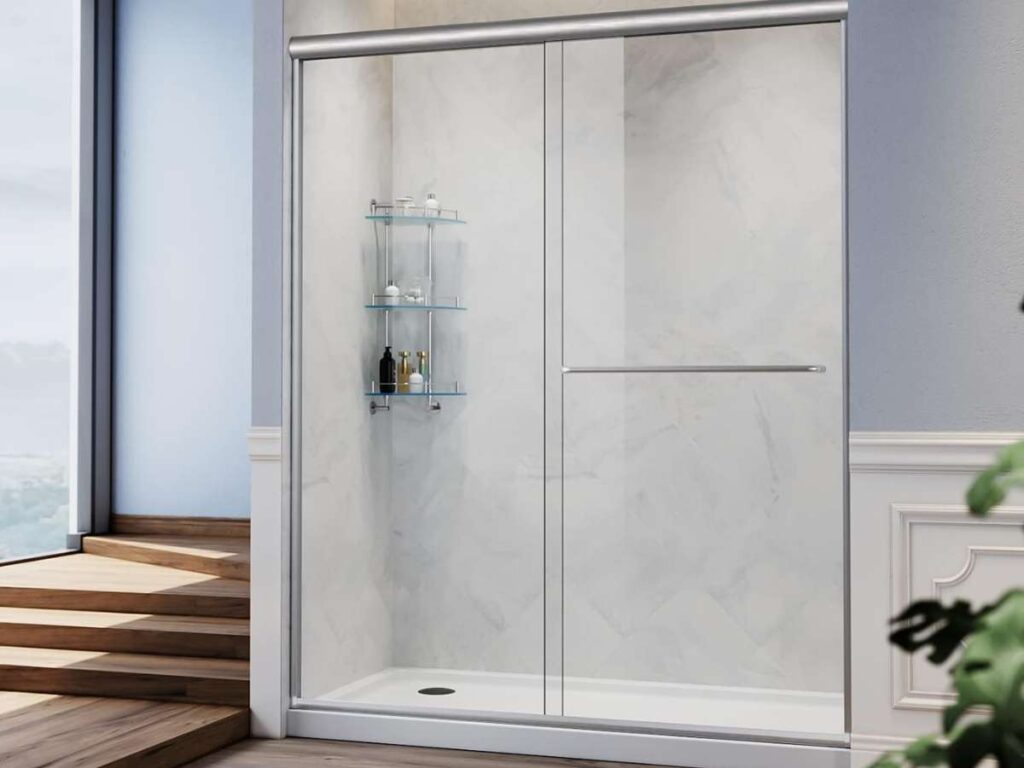
2. Pocket Doors
Pocket doors have come up many times in my projects. I remember one hotel owner telling me they were tired of guests bumping into bathroom doors that swung into narrow hallways. We solved it with pocket doors, and the feedback afterwards was much better.
Space and Layout Benefits
- Frees Up Wall and Floor Space: Because the panel slides into the wall, you don’t lose space for furniture or fixtures. I’ve seen villas where this made room for larger vanities that wouldn’t fit otherwise.
- Improves Guest Flow: In hotels with tight corridors, guests don’t have to fight with swinging doors. This small change makes the room feel more comfortable and easy to move in.
- Adds Flexibility to Design: Since the door disappears into the wall, your design choices are wider. One client was able to fit storage cabinets where a swing door would have blocked them.
Installation and Maintenance Notes
Installation
- Wall Reinforcement Is Needed: A pocket door needs a wall cavity, which has to be planned in advance. On one retrofit project, the contractor had to rebuild part of the wall—something to keep in mind for older properties.
- Precision Framing Required: If the framing is even slightly off, the panel won’t slide well. I always remind teams that this step takes more care than a regular door.
- Track and Roller Quality Matters: Hotels see constant use. I recommend heavy-duty rollers since I’ve seen lighter systems wear out too quickly in busy settings.
Maintenance
- Track Cleaning Is Important: Dust and debris can gather inside the wall cavity. Housekeeping needs to schedule regular checks so the slide stays smooth.
- Roller Replacement Over Time: Rollers wear down after years of daily use. I’ve replaced them in high-use hotels about every 5–7 years, which is expected.
- Damage to Cavity Can Be Hard to Fix: If something goes wrong inside the wall, repairs take longer than with surface-mounted systems. Owners should budget for that possibility.
Cost Considerations
- Basic Pocket Door Systems: Standard wood pocket doors with a track system usually run $200–$400 per unit.
- Glass Panel Pocket Doors: Frosted or tempered glass options add about 15–30% more per door. For a hotel with 50 bathrooms, that difference becomes significant.
- Labor and Framing Costs: Because walls must be opened or built with cavities, labor is higher. Installers often charge $250–$500 extra per door just for framing and fitting.
- Long-Term Maintenance Costs: Roller replacements are fairly inexpensive, around $50–$100 every 5–7 years. This cost is minor compared to the space savings pocket doors bring.
Design Fit for Your Project
Pocket doors work especially well in projects where every square meter matters. In hotels, they open up narrow layouts and prevent guest complaints about cramped spaces. Villas and B&Bs with smaller bathrooms also see big improvements from this design.
They also add a clean, modern touch to the interior. Since the door disappears into the wall, the look is seamless, and it blends well with both budget builds and high-end designs. For owners, that balance between space efficiency and modern style is what makes pocket doors worth considering.
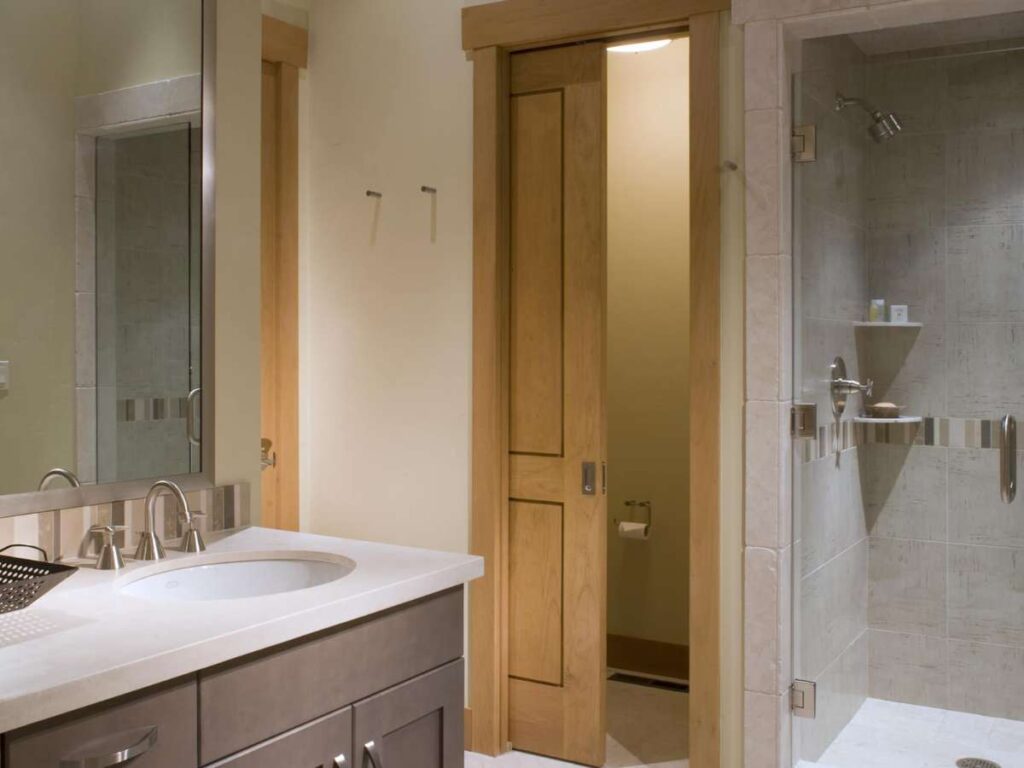
3. Frosted Glass Panel Doors
Frosted glass panel doors often come up in my conversations with hotel and villa owners. I remember a project where the owner liked the open feel of glass doors but worried about privacy for guests. Frosted glass solved that problem right away, and the bathrooms looked brighter without feeling exposed.
Space and Layout Benefits
- Balances Light and Privacy: Frosted glass lets natural or artificial light pass through while blocking clear views. In hotels, this creates bathrooms that feel bright but still private.
- Makes Small Bathrooms Feel Bigger: The soft light through frosted panels reduces the “boxed-in” feeling. I’ve seen this transform compact bathrooms in inns and guesthouses.
- Blends Well With Modern Interiors: The simple, matte finish matches clean and contemporary styles. Many villas use frosted glass doors to maintain a calm, minimal look.
Installation and Maintenance Notes
Installation
- Requires Quality Glass Panels: Frosted glass is usually tempered for safety. I always recommend tempered panels since they are stronger and meet most project safety codes.
- Correct Frame Choice Matters: Aluminum or stainless-steel frames work best in humid bathrooms. Wooden frames may warp or absorb moisture over time.
- Precision Handling Needed: Glass doors are heavy and fragile during installation. Professional crews with the right tools are a must for safe fitting.
Maintenance
- Easy to Clean With Simple Products: Frosted glass doesn’t show fingerprints as much as clear glass, but it can collect soap scum. Basic glass cleaner or vinegar solutions keep it clear.
- Durable in Moist Conditions: Unlike wood, glass won’t warp in humidity. Owners save money by avoiding frequent replacements in tropical climates.
- Check Seals and Frames Regularly: Over time, seals may loosen, allowing water to leak. Regular checks during maintenance cycles prevent this issue.
Cost Considerations
- Standard Frosted Glass Doors: A simple frosted tempered glass panel with aluminum frame usually costs $300–$500 per unit.
- Premium Frameless Options: Frameless frosted glass doors cost more, ranging from $600–$900 per unit. These are common in luxury villas and high-end hotels.
- Installation Labor Costs: Professional fitting can add $200–$400 per door. This includes handling, alignment, and sealing to prevent leaks.
- Long-Term Maintenance Costs: Cleaning supplies are minimal, but replacing seals or frames over time may cost $50–$150 every few years depending on usage.
Design Fit for Your Project
Frosted glass panel doors are a safe choice when you want a balance of style and privacy. In hotels, guests often comment positively on the brightness and modern look. Villas and inns also benefit because the door makes small bathrooms feel more open without sacrificing discretion.
They also suit projects that want a modern yet understated design. The matte finish blends seamlessly into interiors with natural stone, wood, or metal accents. For owners, this door type offers the right mix of practicality and sophistication.
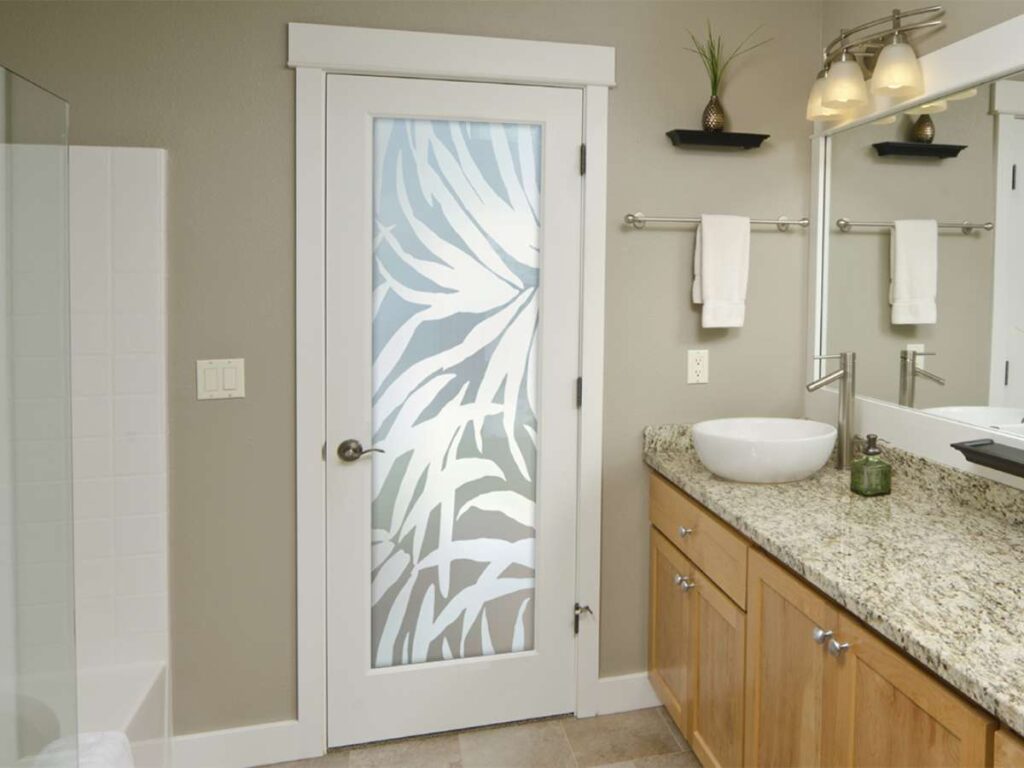
4. Barn-Style Sliding Doors
Barn-style sliding doors have grown popular in villas and boutique hotels. I remember one villa project where the owner wanted bathrooms to feel rustic but still modern. The barn-style system delivered that look while also saving space, and guests later said it gave the rooms more character.
Space and Layout Benefits
- Saves Floor Space: Like other sliding systems, barn doors don’t need clearance to swing. This is useful in compact bathrooms where space is limited.
- Adds Decorative Value: The exposed track system becomes part of the design. Many owners use it as a feature to stand out in guest bathrooms.
- Works Well with Wide Openings: Barn doors can be made wider than standard panels. I’ve seen them used in suites where the bathroom entry needed a large, bold opening.
Installation and Maintenance Notes
Installation
- Requires Strong Wall Support: The track and rollers hold a heavy door. I always remind contractors to secure the track into studs or reinforced walls.
- Precise Alignment Needed: If the track isn’t level, the door will roll unevenly. In one project, we had to reinstall because the initial setup caused the panel to drift open.
- Clear Wall Space Is Important: Since the panel slides outside the wall, you’ll need enough wall area beside the doorway. Furniture or switches can’t block the path.
Maintenance
- Track Cleaning Is Simple: The exposed hardware makes it easy to wipe down. Routine cleaning keeps the rollers free of dust.
- Roller and Hardware Checkups: With frequent use, rollers may loosen. A quick tightening during regular maintenance keeps them working smoothly.
- Protecting Wood Surfaces: If the door is solid wood, humidity can cause swelling. A sealed finish is important to keep the door in good condition.
Cost Considerations
- Basic Barn Door Packages: Standard wood barn doors with exposed track systems cost around $400–$600 per unit.
- Premium Custom Designs: Solid hardwood panels or glass-and-metal combinations range from $700–$1,200 per door. These are more common in boutique hotels and upscale villas.
- Installation Labor Costs: Fitting the track and securing wall support usually costs $200–$350 per door, depending on wall type and material.
- Long-Term Maintenance Costs: Replacing worn rollers or hardware over time averages $50–$100 every few years. If the door is wooded, refinishing may add $100–$200 every 5–7 years.
Design Fit for Your Project
Barn-style sliding doors stand out as more than just functional panels. They bring a rustic, bold character to a space while solving practical layout issues. For villas and boutique hotels, this can become a design feature that guests remember.
These doors also adapt to a range of interiors. A natural wood finish gives warmth, while metal-and-glass barn doors create a more industrial tone. For projects looking to combine space savings with strong visual appeal, barn-style doors deliver both.

5. Flush Wood Panel Doors with Hidden Frames
Flush wood panel doors with hidden frames are often chosen for high-end projects. I remember working with a hotel team that wanted bathrooms to look sleek with no visible edges. Once the hidden-frame doors were installed, the entire hallway felt more refined, and guests later described the rooms as “polished.”
Space and Layout Benefits
- Creates a Seamless Look: Hidden frames blend into the wall, leaving only the flat wood panel visible. This creates a smooth, uninterrupted surface that elevates the whole space.
- Makes Small Bathrooms Look Tidy: Without bulky frames, the door looks lighter. In villas, I’ve seen this reduce visual clutter in smaller bathrooms.
- Supports a Minimalist Design: Many designers choose this style to achieve a clean, modern layout. It works especially well in projects where every detail needs to be subtle yet functional.
Installation and Maintenance Notes
Installation
- Precise Wall Preparation Needed: The wall must be flush for the hidden frame to fit seamlessly. This takes careful planning during construction or renovation.
- Requires Skilled Installers: Unlike standard doors, alignment must be perfect or the edges will show. I’ve always advised owners to hire teams with experience in hidden systems.
- Durable Frames Are Important: Even though they’re hidden, the frames carry the weight. Using quality systems, helps prevent sagging over time.
Maintenance
- Easy Panel Cleaning: Flat wood panels are simple to wipe down. A damp cloth usually keeps them looking new.
- Watch for Moisture Exposure: In bathrooms, untreated wood can swell. Proper sealing is needed to protect the panels.
- Frame Inspections During Maintenance: Because the frame is hidden, any issues may go unnoticed. Regular checks ensure the door remains stable and aligned.
Cost Considerations
- Standard Flush Wood Panels: A basic hidden-frame wood door costs around $400–$600 per unit, depending on wood type and finish.
- Premium Veneered or Custom Finishes: Veneered wood or specialty finishes raise the price to $700–$1,200 per door. Luxury villas often choose this level for aesthetics.
- Installation Costs: Skilled fitting adds $250–$400 per door. Since precision is critical, contractors may charge more than regular wood doors.
- Long-Term Maintenance: Refinishing or resealing wood every 5–7 years can cost $100–$200 per door. This keeps panels resistant to moisture and daily wear.
Design Fit for Your Project
Flush wood panel doors with hidden frames are best suited for projects aiming for a modern and elegant style. Hotels often use them in corridors where consistency and a high-end impression matter. Villas benefit too, since the minimalist finish matches both traditional and modern interiors.
If your project values detail, this design is worth considering. The hidden frame creates a seamless wall-to-door effect, and the flat wood panel adds warmth without clutter. Combined with durable hardware, these doors balance refined design and practicality for long-term use.
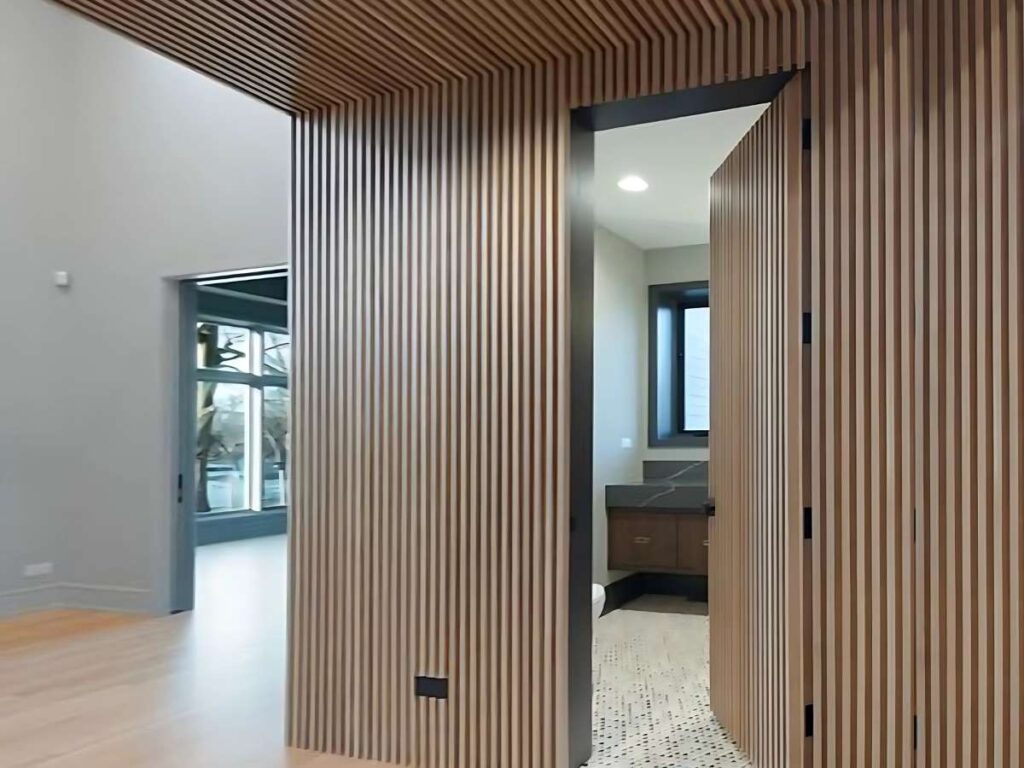
6. Bi-Fold Bathroom Doors
Bi-fold bathroom doors have been a practical solution in many projects I’ve worked on. I remember one guesthouse where space was so tight that a swing door blocked half the bathroom. Switching to bi-fold doors made the area more functional, and the owner later told me it reduced guest complaints right away.
Space and Layout Benefits
- Maximizes Narrow Openings: Since the panels fold instead of swinging wide, they use far less space. I’ve seen them make small bathrooms in villas and B&Bs much easier to move around in.
- Improves Accessibility: The wider opening makes entry smoother compared to a pocket or sliding door. Guests carrying bags or families with kids find this very practical.
- Adds Flexibility in Design: Bi-fold doors can be sized to fit both small and medium bathrooms. For projects with irregular layouts, they adapt better than traditional hinged doors.
Installation and Maintenance Notes
Installation
- Straightforward Fitting Process: Bi-fold systems attach with simple hinges and a track, which keeps installation time shorter than pocket doors.
- Wall and Floor Clearance Needed: The panels need space to fold neatly. Planning the door placement carefully avoids hitting fixtures or furniture.
- Quality Hardware Is Key: Hinges and tracks handle repeated folding. I often recommend reliable brands, since their hardware holds up well in high-use environments.
Maintenance
- Hinges Need Periodic Tightening: Over time, screws can loosen from constant folding. Regular checks prevent misalignment.
- Easy Surface Cleaning: Panels made from wood, PVC, or composite wipe down quickly. This makes them simple for housekeeping to manage.
- Track Cleaning Prevents Jamming: Dust and moisture can collect in the bottom track. A quick cleaning during routine maintenance keeps the panels sliding smoothly.
Cost Considerations
- Standard Bi-Fold Doors: Basic wood or PVC bi-fold doors cost around $150–$300 per unit, making them one of the more affordable bathroom door types.
- Upgraded Composite or Glass Options: Composite or glass-paneled bi-folds range from $350–$600 per door, often chosen for mid-range hotel or villa projects.
- Labor Costs: Installation usually runs $150–$250 per unit, less than pocket or hidden-frame systems since wall modifications aren’t needed.
- Long-Term Maintenance: Replacing hinges or rollers every 5–7 years may cost $30–$80 per door, which is manageable for most owners.
Design Fit for Your Project
Bi-fold bathroom doors fit projects that need space-saving solutions at a lower cost. They’re common in guesthouses, inns, and smaller villas where owners want efficient layouts without major construction changes.
They also work well in modest hotel projects. While they may not carry the same visual impact as a sliding glass or hidden-frame door, their practicality and adaptability make them a strong choice where budget and space are top concerns.
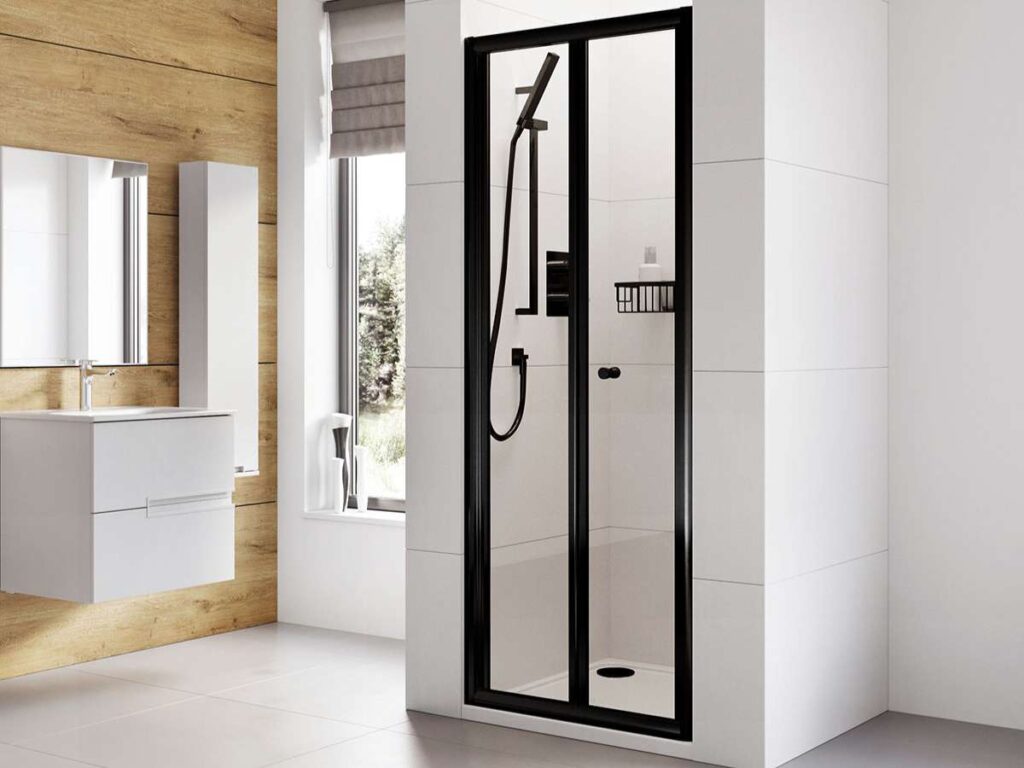
7. Mirror Finish Doors
Mirror finish doors are often chosen when owners want function and design in one product. I remember a villa project where the bathrooms felt dark and narrow. After we installed mirror finish doors, the rooms looked larger, and the owner told me guests noticed the difference immediately.
Space and Layout Benefits
- Creates the Illusion of More Space: A mirror surface reflects light and makes bathrooms appear larger. This is especially useful in smaller hotel rooms or villas where every square meter matters.
- Adds Extra Function Without Taking Space: Guests appreciate having a mirror right on the door. It reduces the need for additional wall mirrors, saving valuable space.
- Brightens Dark Bathrooms: By reflecting available light, mirror finish doors make dim spaces feel brighter. I’ve seen this transform older guesthouses without much natural light.
Installation and Maintenance Notes
Installation
- Proper Weight Support Is Key: Mirror finish doors are heavier than standard wood panels. Frames and hinges must be reinforced to hold the extra load.
- Secure Mounting Prevents Shattering: Professional installation ensures the mirror is bonded safely to the panel. In one project, the contractor used subpar adhesives and had to redo the work.
- Works With Different Door Types: Mirror finishes can be applied to sliding, hinged, or bi-fold doors. Vallisco, for example, supplies mirror door systems adaptable to multiple designs.
Maintenance
- Easy to Clean: A simple glass cleaner removes fingerprints and water spots quickly. Housekeeping staff can add this to their regular cleaning schedule.
- Watch for Edge Wear: If the mirror isn’t sealed well, moisture can creep into the edges. Sealing during installation helps avoid this problem.
- Replaceable Panels: If the mirror surface is damaged, panels can be replaced without changing the whole door. This reduces long-term costs.
Cost Considerations
- Standard Mirror Finish Doors: A basic mirror-coated MDF or wood door costs around $300–$500 per unit.
- Premium Options With Full-Length Panels: Full-length mirror finishes on both sides can range $600–$900 per door, often chosen for upscale hotels.
- Labor Costs: Installation labor runs $200–$350 per unit, depending on door size and weight. Reinforced hinges or frames may increase costs slightly.
- Maintenance Costs: Replacing a damaged mirror panel averages $100–$200, which is less than replacing the entire door.
Design Fit for Your Project
Mirror finish doors fit projects where space and brightness are top priorities. Hotels often choose them for compact rooms, where guests appreciate both the look and the added function of a mirror without extra furniture. Villas also benefit, especially in bathrooms where natural light is limited.
For owners aiming to combine style with practicality, these doors are a solid choice. They enhance the guest experience, make bathrooms feel more open, and reduce the need for extra wall fittings. In short, they bring both efficiency and appeal to your project.
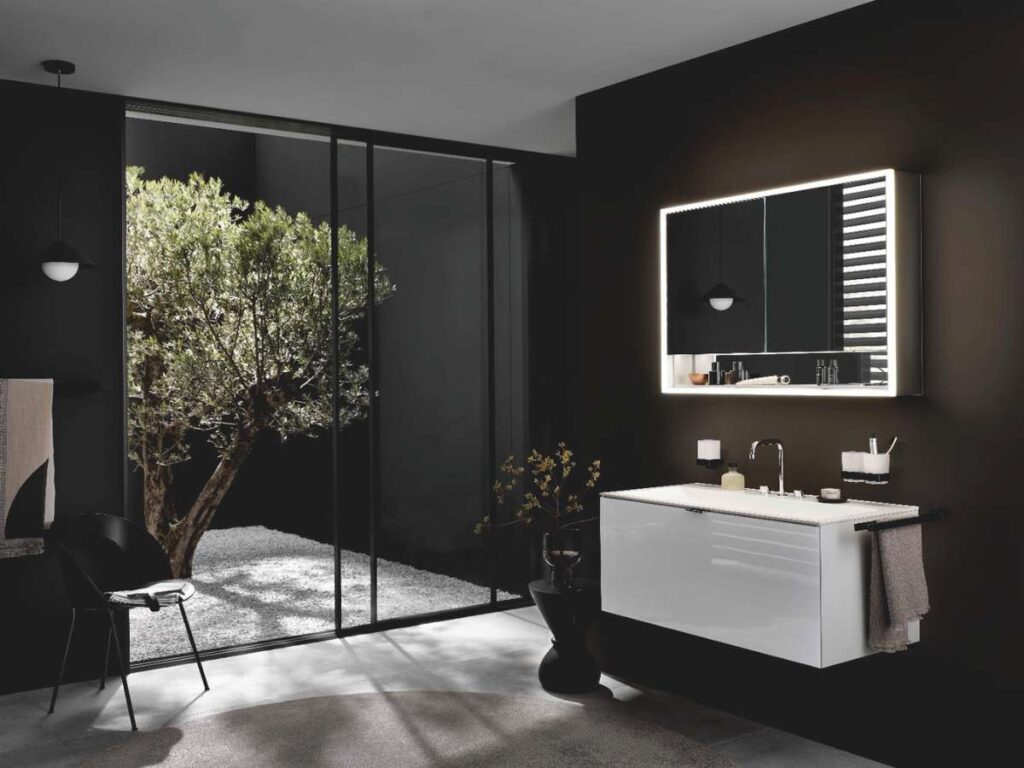
8. Pivot Doors with Vertical Handle Bars
Pivot doors with vertical handle bars often catch attention as soon as they’re installed. I remember a villa project where the owner wanted something bold and different for guest bathrooms. Once the pivot doors were in place, the rooms felt more upscale, and guests commented on how striking the entrances looked.
Space and Layout Benefits
- Creates a Strong Visual Statement: Pivot doors rotate on a central hinge, giving bathrooms a modern and dramatic entrance. In luxury hotels, they make bathrooms stand out as part of the design.
- Allows Wider Door Panels: Pivot systems support larger and heavier panels than standard hinges. This works well in villas or suites with spacious layouts.
- Smooth Operation: The pivot mechanism makes the door easy to open, even with heavy panels. Guests experience a softer, fluid motion compared to standard swing doors.
Installation and Maintenance Notes
Installation
- Requires Floor and Ceiling Anchors: Pivot doors don’t rely on side frames, so the pivot system must be anchored securely at the floor and ceiling.
- Professional Alignment Is Needed: If the pivot point is even slightly off, the door won’t swing properly. Skilled installers are essential here.
Maintenance
- Check Pivot Bearings Regularly: Bearings carry most of the weight, so they need inspections. A worn bearing can cause the door to drag.
- Keep Vertical Handles Clean: Large handles collect fingerprints. Housekeeping should add regular cleaning to their routine.
- Monitor Floor Anchors for Stability: Anchors may loosen over time for heavy use. Quick checks during maintenance prevent alignment issues.
Cost Considerations
- Basic Pivot Door Systems: Standard wood or MDF pivot doors with vertical handles cost around $500–$800 per unit.
- Premium Glass or Metal-Frame Versions: Frameless glass or metal-and-wood combinations range $1,000–$1,800 per door, often chosen for luxury hotels and high-end villas.
- Installation Costs: Skilled installation with floor and ceiling anchoring typically costs $300–$500 per door, reflecting the precision required.
- Long-Term Maintenance: Replacing pivot bearings every 5–7 years may cost $100–$200 per door. Handle replacements add $50–$100 if needed.
Design Fit for Your Project
Pivot doors with vertical handle bars are ideal for projects aiming for a modern, bold aesthetic. They fit best in spacious villas and luxury hotels, where the size and look of the door add to the overall guest experience.
They also serve projects that want a balance between function and statement design. With durable hardware and clean lines, pivot doors elevate bathrooms while staying practical for daily use. For owners, they make bathrooms feel like part of the overall architectural design, not just a utility space.
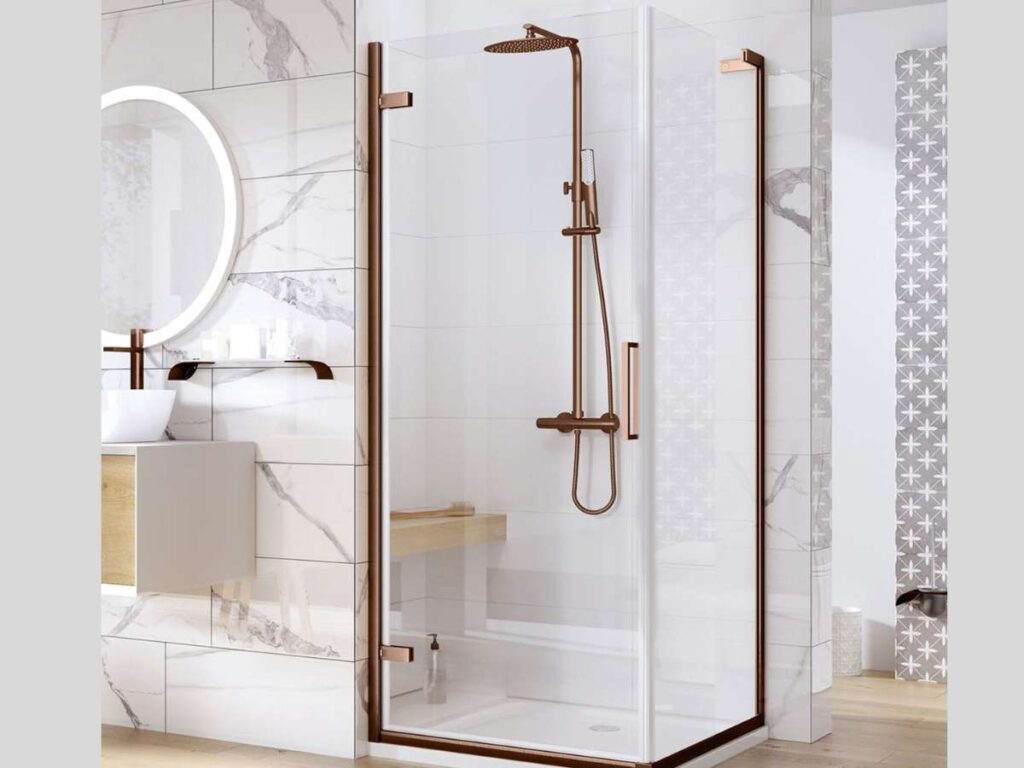
Factors to Consider Before Choosing a Bathroom Door
Choosing the right bathroom door is about more than style. I’ve sat down with many hotel and villa owners who realized too late that small details like moisture protection made a big difference. If you’re weighing options, here are the key factors I always recommend you consider:
- Bathroom Size and Flow: Look at how much clearance your layout allows. In compact bathrooms, pocket or bi-fold doors make movement easier, while pivot doors need more open floor space. Planning the flow early prevents expensive layout changes later.
- Strength and Moisture Resistance: Bathrooms face constant humidity, so your doors must be built for it. Sealed wood panels, tempered glass, or anti-rust metal frames hold up best. Investing in the right build quality keeps doors working for years.
- Upfront Price vs. Long-Term Value: It’s easy to focus on the unit price alone, but installation and upkeep matter just as much. A $450 sliding glass door with strong hardware might last twice as long as a $300 option that fails quickly. Long-term savings often come from better materials and fittings.
- Comfort and Guest Impressions: Always think about how your guests will experience the space. A well-chosen door makes bathrooms feel more welcoming and reflects positively on your property.
Conclusion
That hotel client who once felt their bathrooms looked unfinished finally solved the problem—by choosing the right doors.
Every design choice, from sliding glass to eco-friendly bamboo, changes the way a bathroom looks and works.
In this article, you’ve seen how different door styles save space, improve comfort, and leave a lasting impression on guests.
Now it’s your turn to decide which design will serve your project best. Vallisco supplies bathroom doors built to last and suited for all types of properties.
Ready to upgrade your spaces with the right doors? Contact us today!
Explore More Helpful Resources
There’s more to explore! Check out our additional product selections to find exactly what you’re looking for:
Still haven’t found what you’re looking for? Don’t hesitate to contact us. We’re available around the clock to assist you.




